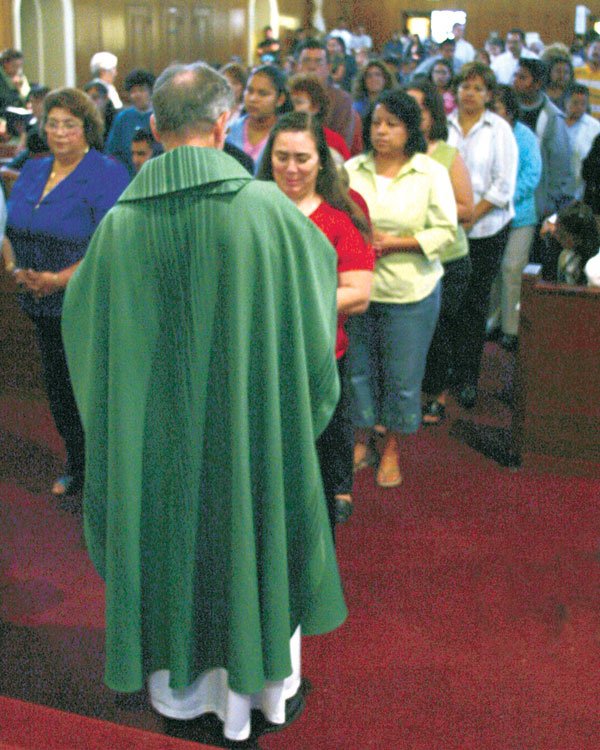Gilroy’s St. Mary Parish plays unusual and critical role
– it’s part Catholic Church, part Mexican Consulate
Gilroy – Eduardo Rincón came to Gilroy from Santiago de Queretaro City, Mexico in 1990, a lonely traveler with a drinking problem.
“I didn’t know anybody. I didn’t have a lot of friends,” Rincón said recently. “I drank a lot in Mexico. I felt sad because I didn’t speak any English.”
But Rincón immediately felt at home in St. Mary Catholic Parish. It was there he met people who helped him stop drinking and find a job. They told him what to do if he was ever stopped by the police.
“They gave me a lot of advice about the community here,” Rincón said. “They helped me a lot. I’ve never had any problem with the police.”
It’s not unusual to get counseling and care at a Catholic church, but in Gilroy, a city where more than a third of the population speaks Spanish and little or no English, and many residents are recent immigrants, St. Mary plays a most unusual role: part Catholic Church, part Mexican Consulate.
Whether it’s for addiction or relationship counseling, career or education advice, healthcare or civics and immigration instruction, Gilroy’s Spanish speakers almost all go to the same place.
“We have to be ready for them any time,” Rev. Francisco Miramontes said after a recent Wednesday afternoon Spanish service. “If any person in the community has an emergency, they come to us. If they need orientation, they come to us.”
And they come at all hours. Miramontes said that one difference between Gilroy’s American and Mexican cultures is that native Mexicans tend to not make appointments when they need help or counseling. It’s not unusual for the phone to ring in the middle of the night.
“They are not prepared to make appointments,” Miramontes said. “They show up and we need to talk with them and give them time. We have to be ready for them at anytime.”
Before he came to Gilroy four years ago, Miramontes spent five years at St. Catherine’s Parish in Morgan Hill, a church that he said has more balance despite having many Hispanic parishioners.
“We have different problems here,” Miramontes said. “We have more immigrants. We have people with college education and people with no education, field workers. It’s more challenging.”
But it’s clear that Gilroy’s longtime Hispanic residents and recent immigrants have forged a strong community at St. Mary. Without fail, more than 1,000 people attend the main Spanish mass each Sunday morning, and the Wednesday afternoon service is getting popular enough that it may move from the chapel to the church.
In all, there are four Spanish masses each week, celebrated by Miramontes and Monsignor John Coleman, and occasional bi-lingual masses that bring Spanish and English speakers together.
And many native Hispanics who came to Gilroy decades ago say they have seen the good St. Mary has done for the community and the way people’s lives change for the better when they join the church.
“There’s a spiritual hunger here,” said Lupe Rodriquez, who’s been attending St. Mary since 1975. “People see the changes God has made in their lives and now they’re more directed to serving the Lord. Going out and helping others. Some people know coming here helps them go on for another week.”
In addition to the formal programs of the church, there are a number of parishioner groups to help immigrants adjust to life in America. At a recent fundraising breakfast, church member Ivan Figueroa was handing out flyers for the Cursillo de vida Cristiana, a support group that meets each Monday.
“We try to meet people in the church and talk about what is proper for people to live here,” Figueroa said. “The best way to live with other persons and their families. Maybe they need help finding a home or finding a job.”
Figueroa credits the Cursillo with changing his life when he came to Gilroy three years ago from Mexico City. When he arrived he was a struggling single father with a drinking problem. Now he’s sober and works at a body shop.
“These meetings helped me get a new life,” he said.
Another popular organization is the Juventud Cristiana, a support group for people from 18 to 35 years old. Juan Pablo Herrera, who came here from Michoacan, has been a leader of the group for about four years.
“We meet to help the [younger people],” Herrera said. “We bring in people who can talk to them about their problems. Street drugs, alcoholism. How to incorporate the Bible and Christianity into their lives.”
Miramontes said that the worst cases he deals with are good people crumbling under the pressure of making a new life in a strange land without money or language skills. The church, he said is the ideal place for them to go because they get critical spiritual support along with practical guidance for building better lives.
“They want to work, they want to improve their lives,” he said. “They want to change the bad things to good and live their faith. They want to feel like this is their own town and overcome the difficulties of their situation.”
But as Spanish speakers become more integrated into the community, they let go of some differences more easily than others. When he’s mixing with the Mexican community, for instance, Miramontes has to remember that he’s on a pedestal.
“If I go to a gathering with the English-speaking community, it’s usual to drink a cup of wine,” Miramontes said. “To the Hispanic community, priests don’t drink or smoke.”
Matt King covers Santa Clara County for The Dispatch. Reach him at 847-7240 or mk***@************ch.com.













